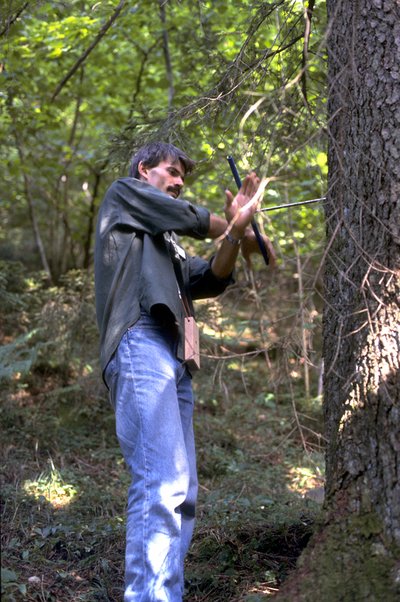Methods used in tree ring analysis

Fig. 1 - Removal of a drill core from a fir tree. Samples and data from tree ring analysis can be used to interpret past development processes of individual trees or whole stands. Photo: Ulrich Wasem (WSL)
Drill cores and cross sections are suitable for tree ring analysis. Cross sections are more suitable for tightly ringed growth, because wedged or missing growth rings can only be located in cross sections. Samples taken for circumference development analysis are best taken at chest height (1.3 m trunk height) analogue to reference heights in forest inventories and operating models. To work out height development several cross sections taken along the trunk are necessary. (Fig. 3)
If the analysis is aimed at main stand development then samples are only taken from the dominating tree species. However, if there are questions relating to stand dynamic then the inclusion of all social classes or development levels may be necessary. Coniferous wood and ring porous to semi ring porous deciduous wood, which exhibit well differentiated growth ring structures are relatively easy to work with. Diffuse porous deciduous wood such as birch or maple usually require additional colouring to make the growth rings better visible.
Growth processes using different strategies can be tested by field experiments which employ adequate experimental and control areas. The choice of these control areas must be carefully considered: stands must not only be comparable in regard to dominating site conditions but species composition, age structure and stand history must also be taken into account.
Medium to long term processes call for special methods of data processing. Many effects such as aging, silviculture and sort term environmental factors flow into the growth pattern influencing and blurring each other. There should therefore either be a wide age or treatment dissemination in the analysis material or only stratified material should be used, e.g. one age group only.
Competition visible in tree ring structures

Fig. 2 - Sudden improvement in growth after a neighbouring tree is felled. The time of felling is marked in blue. Photo: Fritz Schweingruber (WSL)

Fig. 3 - Trunk analysis of a 24 year old fir tree showing height/circumference development. Programme Stanly © J. Nagel, NFV Göttingen.
In cultivated forests all silvicultural units are excluded. A forest stand is characterized by the fact that it is uniform in its composition of trees, that is to say its species composition, perhaps also in its age, structure and texture. The trees of a stand are a living community, offering each other protection against various influences such as wind and transpiration stress (micro climate, rejuvenation). However they compete for light, water and nutrients.
These complex proximity relationships of the trees are reflected in the growth ring structure (fig.2). Therefore an evaluation and interpretation of tree competition and changes in this competition using tree ring analysis provide an important basis for understanding forest dynamics.
Forest dynamics are not a sole product of forest management; natural disturbances can also play a role. Therefore trial areas are needed where the forest history is well documented. Only once natural and human influences are separated can the various factors which lead to changes in tree ring structure be differentiated.
Uses of tree ring analysis for forest management
Past development processes on individual trees and stands can be interpreted using samples and data material used in tree ring analysis (Fig.2). Tree ring analysis can supply the forest manager with important information on height, circumference and volume development and provide possible data on natural disturbances, growth reduction and their possible causes. The forest manager therefore obtains useful information for correcting his management aims and measures. Follow up reactions taken by management can also be analysed. For instance:
- Effects of new steep banks: due to road building, or regeneration slits: reactions in quality due to pruning and crown pruning
- Effects of the use of fertilisers due to lack of nutrients
- Effects of the use of sewage sludge or wood ash recycling in the forest
- Effects of changes in the ground water level
- Effects of ground damage due to forest vehicles
- Encouragement of internal quality criteria for a high quality end product: regular growth ring production, technical qualities of the wood
Tree ring analysis is ideal for providing answers to climate, ecological and environment problems and for interpreting short term disturbances and long term trends. Recently growth trends have been especially relevant in regards to forest damage, deposition (nitrate, acidity), the CO2 problem and climate change. Short term disturbances of the forest ecosystems are:
- Periods of drought
- Frost and drops in temperature
- Storms
- Geomorphologic processes
- Insect and pathogen damage
- Consequences of pollutants during temperature inversions (keyword: respirable dust)
- The effect of non-ionising radiation
Although these disturbances are not caused by use of the forest the results of tree ring analysis give forest managers information to help estimate risks and reduce damage.
Conclusion
On the one hand tree ring analysis examines, retrospectively, the growth process during the whole of a tree’s life span. It makes statements about the point in time, the duration and the intensity of management actions and it evaluates results and consequences. On the other hand tree ring analysis interprets existing growth patterns in view of man made causes and predicts future forest developments and possible alternative scenarios. It therefore helps to optimise forest management concepts or help develop new ones.
Translation: Dawn Meister (Stallikon)
